What Are Power Modules in Electronics and Their Applications
September 7, 2022
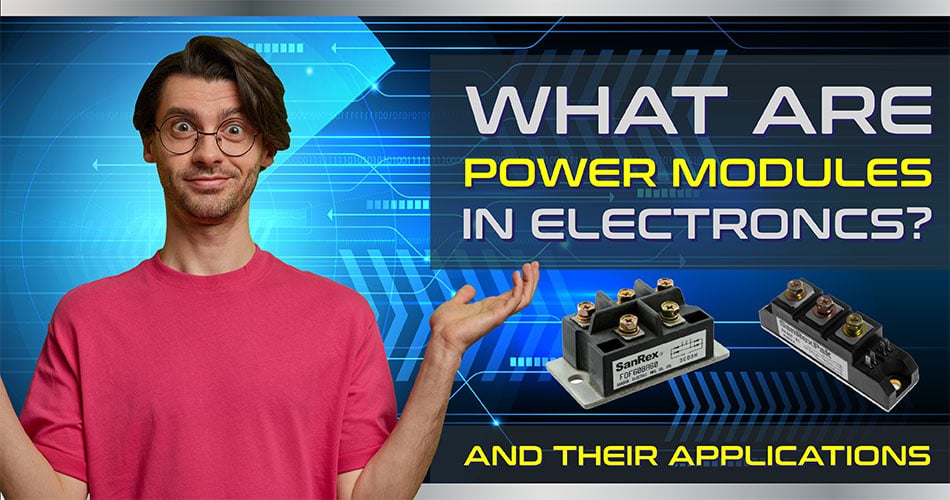
What are power modules for?
To meet the demands for high-power switching solutions, many rely on power modules. Electric cars such as those from Tesla are a good case in point.
Power modules may be small in size, but their reliability is a motivating factor to check them out. They are not seen as one of the workhorse technologies for power switching for nothing.
This post will cover what power modules are, their working principles, and their advantages. Related technologies, such as IGBT and MOSFET, are also covered here.
Latest Technologies Featuring Power Modules
Power modules are moving forward on a variety of fronts and product types. Best for higher voltage applications, they make for potent power-switching devices.
In TI (Technology Integration) terms, a power module contains a DC-DC converter. It integrates the controller and power, FETs and an inductor into a single package.
Often, the unit will include more than these three components. This includes gate drivers, sensing, and protection functions.
Its core function is to perform motor power switching. Another is entering the amplification scene—in electric variable-speed and servo drives.
Some power modules integrate capabilities and intelligence well beyond these basic functions. But to say the least, this is what a power module is.
Power modules definition from three standpoints:
From the electric standpoint, power modules hustle when there is tight physical integration. They reduce parasitic elements in the interconnection of the power semiconductor devices.
From a thermal standpoint, the power module has a thermally conductive baseplate. This can be bolted to a heat sink or cold plate to remove the loss of heat.
From a mechanical standpoint, it provides a robust mechanical package for the components.
In conclusion, power modules are electro-thermo-mechanical devices. And they are optimised for power converter operation.
Power modules are usually used at higher power levels. They may simplify a power converter design thanks to their robust mechanical structure.
Plus, they guarantee proper operation from an electric and thermal point of view. That is, however, as long as the module datasheet specifications and guidelines are followed.
IGBT and MOSFET
Generally, power modules include transistors and diodes. Some combine transistors into used configurations, such as:
- Half-bridge configuration
- H-bridge configuration
These allow you to switch the current direction through a motor from a single voltage power supply. MOSFET and IGBT are a few of the most common switching elements found in them.
IGBT
IGBT stands for Insulated-gate Bipolar Transistor. It is a three-terminal power semiconductor device.
It acts as an electronic switch and features high efficiency and fast switching. Also, it combines the simple gate-drive qualities of MOSFETs with high-current and low-saturation voltage.
Best suited for medium to high-power applications. For example, from air conditioners and stereo systems to trains and electric cars. Large-scale IGBT modules, in contrast, often consist of many devices running in parallel.
An IGBT is suitable for high voltage, high current, and low switching frequency applications.
MOSFET
MOSFET stands for Metal Oxide Semiconductor Field-effect Transistor. It handles significant power levels.
MOSFETs have the advantage of high commutation speed. Unlike their ‘bipolar’ counterpart, they also have good efficiency at low voltages. And thanks to their isolated gate, they are easy to drive.
Power MOSFETs are often used in low voltage (less than 200v) in low voltage applications. Other uses include the following:
- Power supplies
- DC to DC converters
- Low voltage motor controllers
A MOSFET is suitable for low voltage, low current, and high switching frequency applications. It can also conduct in the opposite direction. But this can be adjusted using a freewheeling diode with an IGBT—only if the application is more suited for an IGBT.
Intelligent Power Modules
Power modules have continued to evolve to better meet engineering challenges. Most importantly, to simplify their uses.
Intelligent power modules are one of the recent developments in power module technology. They contain an IGBT with added control and protection circuitry.
Control circuitry provides the driving circuitry for switching the bipolar transistor. Then the gate-drive logic for a simpler turn on and turn off.
Intelligent power module protection circuitry can prevent problems, such as:
- High temperatures
- Excessive current
- Short circuits
- Undervoltage conditions
The components in power modules are potted in plastic with a metal base plate. This allows for adequate cooling when needed under high-power situations.
In the past, power modules used screw contacts. Now, pins and press-fit contacts are available. These contacts allow for high current and high voltage use without soldering. This simplifies installation, removal, and replacement.
Power Module Applications
Applications of power modules are common in electric cars and electric motor controllers. Other uses include:
- AC motor drive front end
- Appliances
- Battery charging
- Cathodic protection
- Converters
- Conveyors
- DC-choppers
- Electroplating
- Elevator controls
- Half-Bridges
- Heater controls
- HVAC controls
- Inverters
- Medical Electronics
- Motor controls, AC
- Motor controls, DC
- Motor starters
- Power Factor Correction
- Power Supplies
- Reverse polarity protection
- Switches
- Three-phase inverters
- Traction
- Transportation
- UPS systems
- Welding
Most high-power switching applications can also be used with power modules.
Advantages of Power Modules
Advancement of high-frequency soft switching technology. Semiconductor process and packaging technology. The power density is getting higher and higher. The same goes for conversion efficiency. And the application is way simpler than ever.
On top of these, power modules have more to offer!
1. Simple and reliable design
There are many types of power modules on the market. There is the AC-DC, DC-DC, and high voltage types, to name a few.
Either way, the design is more compact, thanks to the high-integrated circuit in the module. Depending on the supplier, they can provide professional technical support and system solutions.
Some can even offer peripheral circuits and parameter curves of the module.
2. High reliability
Power modules use an automated process to ensure quality and reliability. Designed with strict standards, developed and conducted for a perfect mass production test.
3. High power, density and efficiency
The module adopts a multi-layer PCB aluminium substrate. This has a high power density and a small volume, saving the space occupied by the system.
At present, the 1/4 brick of the DC-DC module is as high as 1000W. This level is a bit difficult for discrete solutions to meet such standards.
4. Easy to maintain
If a fault occurs, you can replace with another module to get the system working properly. Suppose you need to change the scheme in the middle of the design. You only need to change the modules in it, and there is no need to modify the overall power supply circuit.
5. Save time and money
The power supply module has a variety of input and output options. It can be repeatedly added or cross-added to form a modular combination power supply.
With this, it achieves multiple inputs and outputs. Compared with discrete power solutions, commissioning is simpler and safer. In return, this simplifies design applications and shortens development time.
Get Your Power Modules Here!
We have a large selection of power modules suitable for use in electronic projects.
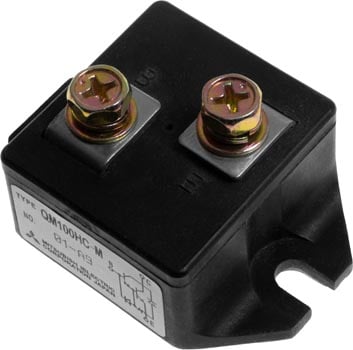
Mitsubishi QM100HC-M High Power Transistor Module
Product code: QM100HC-M
A high-power, switching module that can integrate one or more components into a functional, isolated unit.
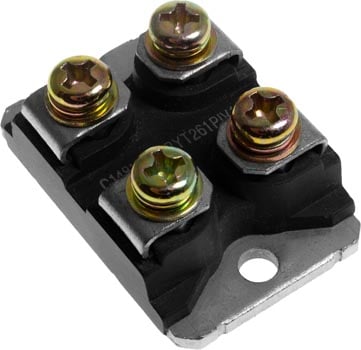
ST BYT261PIV-1000 Fast Diode Isotop Package
Product code: BYT261-1000
Suited for switch mode power supplies and other power converters.
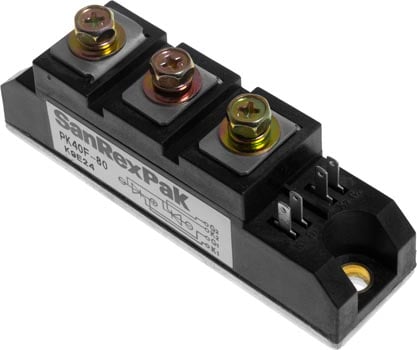
SanRex PK40F80 Thyristor Module
Product code: PK40F80
Designed for various rectifier circuits and power controls. Following internal connections and wide voltage ratings up to 1,600V are available.
It features a high precision 25mm (1″) width package and an electrically isolated mounting base.
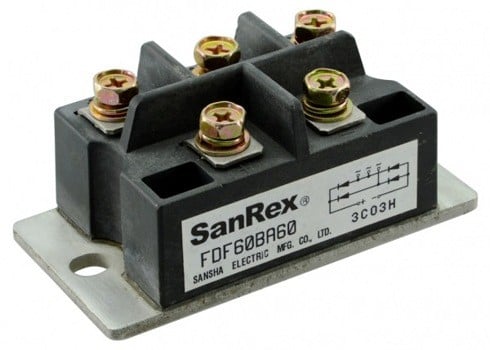
SanRex FDF60BA60 Diode Module
Product code: FDF60BA60
This power diode module is designed for single-phase full wave rectification. It has four fast recovery diodes connected in a single-phase bridge configuration.
Suitable for high-frequency applications requiring low loss and high-speed control.
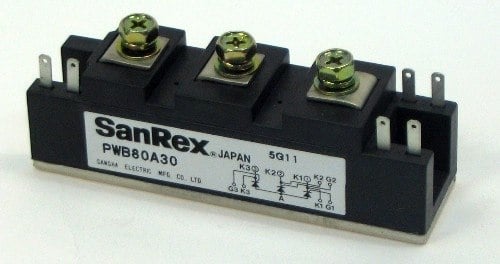
SanRex PWB80A30 Thyristor Pack
Product code: PWB80A30
A non-isolated mounting base as a common anode terminal. Suitable for low voltage, 3-phase rectifier applications. This includes welding and various DC power supplies.
Power Modules vs Discrete Power Solution
A power module offers a validated and specified solution. In contrast, a discrete power supply enables more customisation to the application. Both are valid solutions with various tradeoffs for space-limited applications.
The initial cost of implementing a discrete design may be cheaper than using a power module. But when considering long-term engineering and maintenance costs, power modules show significant advantages. This is particularly true for systems with ten (10) or more power rails.
The reduced designed complexity, a simplified and more flexible PCB layout, and time to market. These are all important factors to consider, which power modules already have.
© Electrotech Brands Pty Ltd 2022


Write a Comment
You must be logged in to post a comment.